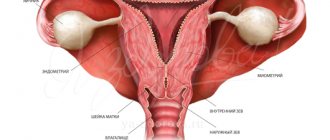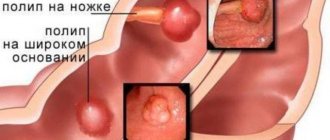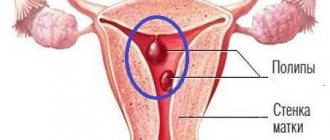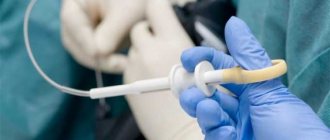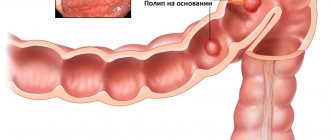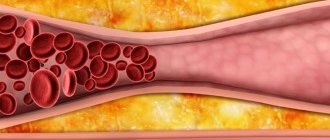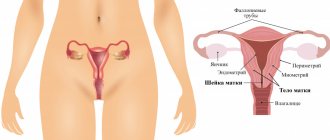Posted by Andro-gynecology clinic on 2017-11-03. Published: Women, Diseases
Endometrial polyp is a focal (limited in area) hyperplasia of the tissue of the mucous membrane of the uterine cavity . Hyperplasia is an excessive growth of endometrial tissue, when foci of hyperplasia there is a lot of talk about endometrial polyposis. It can be suspected by ultrasound, removed by hysteroscopy, the final diagnosis is made after histological examination. Article provided by the site “Minimally invasive gynecology in Krasnoyarsk” - original article.
Types of polyps
A polyp is a benign formation that has a round shape and sizes from 2 mm to several centimeters. With the help of a stalk, the body of the polyp is attached to the base located under the surface of the mucous membrane. Polyps are overgrown endometrium and, like the uterine mucosa, consist of glands and connective tissue. Depending on the predominance of one of these elements, the following are distinguished:
- Glandular polyps of the endometrium, which consist of stromal cells (the structure of the ovarian stroma) and glands. Most often detected in women of reproductive age.
- Fibrous endometrial polyps, which consist predominantly of connective tissue; on the contrary, there are very few glands. This type of polyp is rarely detected, usually in postmenopausal women.
- Glandular fibrous endometrial polyps, respectively, consist of glands and connective tissue. They can appear at any age.
- Adenomatous endometrial polyps consist of glandular tissue, which shows signs of structural changes. This type of polyp has a high probability of malignancy. Usually detected in postmenopausal patients.
Polyposis is said to occur if a single polyp re-forms or several growths are detected.
Classification
Depending on the location of the pathological process, polyps of the organ body and cervix are distinguished. There is also a classification based on the histological structure of neoplasms, according to which polyps are of the following types:
- glandular;
- fibrous (with a predominance of connective tissue);
- glandular-fibrous;
- adenomatous (the histological structure is dominated by altered glandular tissue, prone to proliferation).
Cervical polyps localized in the cervical canal are glandular, covered with single-row columnar epithelium, and epidermal, with metaplastic stratified epithelium. Separately, there are placental polyps that form from fragments of the placenta that has not been completely removed after a complicated abortion, childbirth, spontaneous abortion or frozen pregnancy.
Causes of endometrial polyps
The main causes of endometrial polyposis include the following:
- Ovarian dysfunction caused by increased estrogen levels or decreased progesterone production
- Endocrinopathies
- Surgery in the uterine cavity
- Endometritis
Negative predisposing factors include poor environmental conditions in the region of residence, the use of an IUD, obesity, and decreased immunity.
Despite the fact that endometrial polyps can form at any age, the likelihood of their occurrence increases in women over 35 years of age.
Cause and mechanism of development of the disease
Risk factors for the occurrence of this pathology are:
- The occurrence of hyperplastic processes in the endometrium is facilitated by hereditary burden (uterine fibroids, genital and breast cancer, hypertension and other diseases), damaging effects during intrauterine life, diseases during puberty and associated disorders of menstrual and subsequently reproductive function. In mature women, the appearance of hyperplastic processes is often preceded by gynecological diseases and surgical interventions on the genital organs.
- Hyperplastic processes of the endometrium are often accompanied by obesity , hypertension, hyperglycemia (this triad of symptoms is especially often combined with atypical and hyperplastic processes recognized as precancer of the endometrium), uterine fibroids, mastopathy, eidometriosis, which are largely hormonal-dependent diseases, as well as functional disorders the liver, responsible for the metabolism of hormones. The leading factor in the cause of occurrence and further development belongs to hyperestogenia - an increase in the level of the hormone estrogen.
Symptoms of endometrial polyp in the uterus
The pathology is characterized by:
- Menstrual irregularities such as hypermenorrhea
- Intermenstrual bleeding
- Uterine bleeding in the postmenopausal period
- Dyspareunia
- Pain when urinating
- Infertility
- Cramping pain in the lower abdomen
In some cases, there are no obvious signs of endometrial polyposis. It is characteristic that the intensity of clinical manifestations of endometrial polyposis increases in proportion to the woman’s age.
Diagnostics
- Gynecological examination, during which a polyp protruding from the cervical canal may be detected
- Ultrasound of the pelvic organs, during which thickening of the endometrial layer of a local nature is revealed.
- Hysteroscopy with histological examination of the endometrium, during which it is possible not only to detect polyps, but also to remove them.
Sources
- Salikhova T.R. Pathogenetic aspects of endometrial polyps in postmenopausal women - Dissertation for the degree of Candidate of Medical Sciences. Makhachkala, 2021.
- Pushkarev A.V., Mustafina G.T., Khusnutdinov Sh.M., Mazitov I.M. Endometrial polyps (diagnosis, clinical picture, treatment) – Journal “Creative Surgery and Oncology”, 2010.
- Bagdasaryan L.Yu., Ponomarev V.V., Karahalis L.Yu., Steblo E.I., Penzhoyan G.A. Factors influencing the development of endometrial polyps - Kuban Scientific Medical Bulletin, 2021
Share:
Treatment of endometrial polyps
A procedure such as removal of a polyp in the uterus is resorted to in most cases after confirmation of the appropriate diagnosis. Conservative therapy in most cases does not have any effect, that is, the hyperplastic formation in the uterine cavity remains.
Treatment involves the elimination of the polyp as a foreign body of the uterus and cervical canal, as well as subsequent histological examination of the removed tissue. This is necessary to prevent the development of oncological pathology against the background of hyperplastic processes of the cervix and endometrium.
Indications and contraindications
Removal of a cervical polyp is carried out only if there are certain indications. These include:
- large polyp size (over 10 millimeters in diameter);
- rapid progression of pathology according to control ultrasound examination;
- presence of intermenstrual bleeding;
- infertility. Problems with conception and a history of spontaneous abortion due to an endometrial polyp are an indication for surgical treatment;
- the presence of an adenomatous polyp (precancerous condition);
- malignant growth of formation.
The procedure of polypectomy (removal of a polyp) is contraindicated in the following conditions:
- with pathology of the cervix (cicatricial deformation, lack of patency of the cervical canal, malignant process);
- acute stage or exacerbation of chronic inflammatory process of the cervix (exocervicitis, endocervicitis);
- presence of uterine bleeding;
- colpitis (inflammatory processes in the vagina of various etiologies).
Preparation for surgery
If an endometrial polyp is detected in the uterus, treatment should begin as early as possible. The procedure to remove such a neoplasm of the cavity or cervix requires preparation.
Before undergoing a polypectomy, a woman undergoes an examination, including:
- blood tests: clinical, biochemical, coagulogram (blood clotting test), HIV, syphilis, and hepatitis markers;
- Analysis of urine;
- vaginal smear for flora and atypical cells;
- colposcopy;
- electrocardiography;
- fluorographic examination.
Since the manipulations are performed under anesthesia, the patient must obtain the opinion of such specialists as a therapist, anesthesiologist, or cardiologist. This is necessary to exclude contraindications for surgical removal of the polyp.
In addition to mandatory examinations, when preparing for polyp removal, a woman must adhere to some rules:
- seven days before the expected date of surgery, you should stop drinking alcoholic beverages;
- three days before the intervention, it is worth excluding foods that promote gas formation from the diet;
- You can eat food no later than 10 hours before the operation;
- on the day of surgery you should not eat or drink;
If a woman is taking any medications, this information must be reported to the attending physician/
Expert recommendations
There is no need to be afraid of surgery. Gynecologists in modern clinics treat women without using a scalpel. The polyp is removed in just a few minutes through the vagina. For the patient's comfort, we use light anesthesia. Believe me, it is impossible to treat endometrial polyp with herbal decoctions and tampons - radical methods are necessary. In the early stages, the risk of complications is minimal. Women undergo treatment, plan pregnancy, and become mothers.
Come to our medical center for a preventive examination and diagnosis. Doctors at the Alfa Health Center clinic see patients 7 days a week. The cost of consultation is indicated in the price list on our website.
Polyps in the uterus: surgical treatment methods
In modern gynecological practice, there are several ways to remove polyps of the cervix and uterine cavity.
Hysteroresectoscopy
Hysteroresectoscopy is a modern technique that involves inserting an endoscope equipped with a video camera into the uterine cavity.
When performing this procedure, the doctor has the opportunity to assess the condition of the uterine cavity, visualize the polyp itself, and also remove it using mechanical, electrosurgical or laser instruments. Then a histological examination of the formation is carried out.
Advantages of hysteroresectoscopy:
- removal occurs under visual control and not blindly;
- the polyp is removed along with its stem, which prevents its re-formation in this particular place;
- there is no negative or harsh effect on the uterine mucosa, which is extremely important for women planning a pregnancy;
- the risks of trauma to the uterus and the addition of an infectious process are minimized;
- after the operation, the woman recovers quickly and can be discharged from the hospital in the near future;
- there is no pain;
- This minimally invasive intervention allows us to minimize risks for patients with somatic pathologies.
Fractional diagnostic curettage
This surgical intervention involves blind removal of a uterine polyp by curettage of the uterine cavity and cervical canal.
While conducting this study, the doctor is not able to exercise visual control over what is happening in the uterine cavity.
After separate curettage of the canal and the cervical cavity, the resulting material is also sent for histological examination.
According to statistics, after the procedure of curettage of the uterine cavity, recurrence of polyps occurs in more than 50% of cases. That is why in modern gynecology, if there is a diagnosis of “uterine cavity polyp” or “cervical polyp,” treatment involves hysteroresectoscopy of the polyp.
Pregnancy with endometrial polyposis
Patients with endometrial polyposis may develop infertility. This is due to changes in hormonal levels and difficulties that arise during the implantation of a fertilized egg into the wall of the uterus. According to statistics, removal of polyps significantly increases the chances of both a natural pregnancy and IVF success.
If you have any questions related to polyposis, you can ask them to the doctors at Nova Clinic. You can make an appointment with a doctor by calling the number listed on the website or using the booking button.
Complications
Polyps in the uterus change the properties of the endometrium, making it difficult for a fertilized egg to implant and thereby preventing pregnancy.
In case of successful conception in the presence of neoplasms in the uterus, the risk of miscarriage or stopping the development of the embryo is significantly higher. In addition to infertility, patients with uterine polyps may develop iron deficiency anemia - as a result of large blood loss during or in the intervals between menstruation. This condition is characterized by general weakness, drowsiness, apathy or irritability, decreased performance, brittle hair and nails, and weakened immunity. With severe anemia, shortness of breath, dizziness, and possible loss of consciousness occur. Adenomatous polyps have a high probability of degenerating into cancerous tumors.
